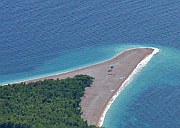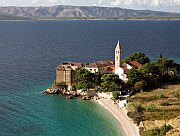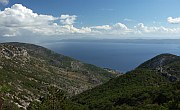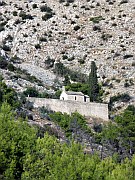This website is an archive from 2016
This site was actively maintained from 2006 to 2016. Since then I have kept it online for historical interest, but have made no further updates. Much of the information in these pages is now incorrect or obsolete.

Zlatni Rat (from Vidova)
Autumn in Bol
Bol, on the south coast of Brač Island, has a split personality. Summer crowds flock to the village and its renowned beach. I visited in the middle of October and found it the perfect place for a relaxing few days of swimming, walking, and generally lazing around. So long as you aren't going for the pulsing nightlife, Bol is a good choice for a low season escape.
There is no doubt that the beach known as Zlatni Rat is Bol's most famous attraction. This shape-shifting spit backed by pine trees features is the star of a thousand posters and a million postcards. Like many celebrities, in real life it turns out to be smaller than you expected. And like most Croatian beaches you couldn't really describe it as sandy, although the gravel here is relatively fine. Apparently the beach is completely covered with bronzing bodies in summer. In October the "crowd" ranged from one person on the cloudy days to perhaps twenty people on the sunny days. I found the water warm enough to enjoy swimming, although the air temperature on emerging from the sea was rather bracing.

Dominican Monastery, Bol

Cat family, Bol
Most of Bol's tourist development has taken place away from the original village and under the cover of the conifer forests that fringe the coast behind Zlatni Rat. As a result it is fairly unobtrusive, and the original Bol Town still looks more or less like an idyllic fishing village. There's not much to do here except admire the cats sunning themselves in its narrow lanes - possibly the most contented-looking cats in a country full of self-satisfied felines.
Any self-respecting Adriatic town has a tall, slender campanile, and Bol is no exception. The bell tower belongs to the Dominican Monastery, located on a headland to the east of the town. Its actual opening hours turned out to bear no relation to the theoretical ones posted on the door, so I can't tell you what it's like inside. Beyond the monastery a tiny whitewashed chapel overlooks the strait between Brač and Hvar.

View from Vidova

Ruins near Murvice
Bol is a good base for walking. The most obvious target is Vidova Gora, the mountain that overlooks the town. You may have to ask for directions to the beginning of the path, but once you get started the trail itself is well marked and in good condition. As is often the case with this kind of limestone landscape, the apparently inhospitable rocky slopes reveal a wealth of small plants, flowers, and butterflies when seen from close up. The whole path is on an unshaded south-facing slope - very pleasant in October sunshine, but probably a punishing climb at the height of summer. It took me about two hours to reach the top. At 778m this is the highest point on any Adriatic island, so it's not surprising that the views are wonderful (if you want the views without the hike, you can also get here by road). The village of Bol is immediately below; Hvar, Vis, and other islands are visible to the south; and to the north the natural limestone pavement of Brač slopes gently away in a maze of clints and grikes. The island is famous for its stone, which was used to build Diocletian's Palace in Split among many other buildings. Almost every Croatian guidebook and tourist brochure claims that the White House in Washington DC was built with stone quarried in Brač, but I haven't been able to track down any American source that mentions this.
Another walk leads along a flat track to the little village of Murvice, 5km west of Bol - you could also take a bike or motor scooter. A little further west and higher up is a village that looks rather like Murvice, except that it has been abandoned and is now in ruins. You can wander around and even get into the church - it's rather an eerie place, especially as the crumbling stones seem to be gradually blending into the rocky hillside. Further west still are gentler vine-covered slopes and a series of lovely coves sheltered by pine trees.
A number of excursions to places of interest in Brač and the neighbouring islands are advertised around Bol Harbour. One of the most interesting is to Hvar Town. Regular ferry connections to Hvar are rather inconvenient, so a boat trip that allows you several hours in the town is a good option.
Practicalities
A direct high-speed catamaran carries passengers between Split and Bol all year round (1 hour), leaving Bol in the morning and returning from Split in late afternoon. Obviously the schedule is designed more for locals than for tourists, but it's a convenient way of getting to Bol. It's also absurdly cheap, apparently because it is heavily subsidised. Alternatively there are at least seven car ferries daily (much more in summer) from Split to Supetar (1 hour), on the island's north coast. Buses link Supetar and Bol. Check ferry schedules on the Jadrolinija website.
Bol has the usual Croatian mixture of private rooms and rather characterless hotels. Although the hotels were open when I visited, I was told that they were about to close for the winter. Private rooms are a bargain in low season - in fact the man who rented me a room refused to name a price and told me to pay what I thought was appropriate. He too said that I would be the last guest of the season, so if you are visiting in midwinter it might be wise to confirm accommodation in advance.
The availability of excursions depends very much on the time of year. During my stay there were a couple of excursions per week to Hvar Town, but I suspect that once the hotels close there may not be any.
More photos of Brač in my Croatia Galleries